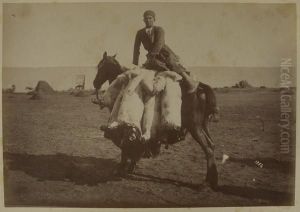Antoine Sevruguin Paintings
Antoine Sevruguin was a photographer of Armenian-Georgian origin who became one of the most prominent photographers in Iran during the late 19th and early 20th centuries. Born around 1830 in the Russian Empire, Sevruguin was part of an ethnically Armenian family that eventually moved to Tehran. His exact birth date is not well-documented, and various sources offer different years ranging from 1830 to 1840.
Sevruguin's father was a diplomat, which allowed the family to travel extensively. Antoine's exposure to different cultures and languages during his upbringing likely contributed to his later success in Iran, where he became proficient in Persian. He initially showed interest in painting, but his artistic pursuits led him to photography, a medium that was gaining popularity and prestige.
In the 1870s, Sevruguin established his photography studio in Tehran, and over the following decades, his work became renowned for its quality and artistic merit. He captured a wide range of subjects, including Persian landscapes, historical monuments, and everyday life, as well as portraits of people from various ethnic and social backgrounds. His work is particularly valued for documenting the cultural and social fabric of Iran during the Qajar era.
Sevruguin's photography studio in Tehran became a hub of cultural activity and attracted a diverse clientele, including members of the Qajar royal family and foreign visitors. His portraits of the royals and the elite helped him gain favor with Naser al-Din Shah Qajar, who was himself interested in photography. Sevruguin's relationship with the royal court provided him with access to many subjects and locations that would have been otherwise inaccessible.
Tragedy struck in the early 1900s when political unrest led to the looting and destruction of Sevruguin's studio, resulting in the loss of many of his glass negatives. Despite this setback, Sevruguin continued to work and rebuild his collection. He remained active in his profession until his death in Tehran in 1933.
Sevruguin's legacy lives on through the photographs that survived the destruction of his studio. His work provides a unique window into the Qajar period and is a valuable resource for historians and art enthusiasts alike. The surviving photographs are held in various collections worldwide, including the Golestan Palace in Tehran and the Smithsonian Institution in Washington, D.C. Sevruguin's mastery of the photographic medium and his ability to capture the essence of Persian culture make him a significant figure in the history of photography.
